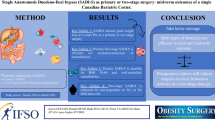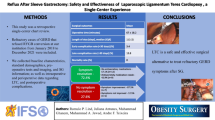Abstract
Purpose
We reviewed our experience of performing laparoscopic sleeve gastrectomy (LSG) in super-superobese (body mass index >60 kg/m2) patients and compared our results with those of laparoscopic adjustable gastric banding (LAGB) performed in similar patients.
Methods
All LSGs performed by our group were reviewed retrospectively. We analyzed only patients whose preoperative body mass index (BMI) was greater than 60 kg/m2 and compared the results with a report in the literature of super-super-obese patients treated with LAGB.
Results
Between October 2000 and November 2005 we performed 63 LSGs for super-super-obese patients whose average preoperative BMI was 68 kg/m2. By 6 months postoperatively, the average BMI had decreased to 58 kg/m2. Forty-three patients subsequently underwent a second-stage duodenal switch procedure within 1 year. The BMI of the 20 patients who did not undergo further surgery decreased further to 50 kg/m2, 1 year after the LSG.
Conclusions
Laparoscopic sleeve gastrectomy is comparable with LAGB for promoting short-term weight-loss in the super-super-obese. The benefits of LSG over LAGB include a decreased need for reoperation; first, because foreign material is not implanted in the body; and second, because the residual ghrelin-producing gastric mass is much smaller.
Similar content being viewed by others
References
Marceau P, Hould FS, Simard S, Lebel S, Bourque RA, Potvin M, et al. Biliopancreatic diversion with duodenal switch. World J Surg 1998;22(9):947–954.
Ren CJ, Patterson E, Gagner M. Early results of laparoscopic biliopancreatic diversion with duodenal switch: a case series of 40 consecutive patients. Obes Surg 2000;10(6):514–523; discussion 24.
de Csepel J, Burpee S, Jossart G, Andrei V, Murakami Y, Benavides S, et al. Laparoscopic biliopancreatic diversion with a duodenal switch for morbid obesity: a feasibility study in pigs. J Laparoendosc Adv Surg Tech A 2001;11(2):79–83.
Gagner M, Boza C. Laparoscopic duodenal switch for morbid obesity. Expert Rev Med Devices 2006;3(1):105–112.
Sue-Ling DJaH. Surgical management of morbid obesity. Third ed. Oxford: Butterworth-Heinemann; 1995. p. 1036–1044.
Regan JP, Inabnet WB, Ganer M, Pomp A. Early experience with two-stage laparoscopic Roux-en-Y gastric bypass as an alternative in the super-super obese patient. Obes Surg 2003;13(6):861–864.
Catheline JM, Cohen R, Khochtali I, Bihan H, Reach G, Benamouzig R, et al. Treatment of super super morbid obesity by sleeve gastrectomy (in French). Presse Med 2006;35(3 Pt 1):383–387.
Langer FB, Bohdjalian A, Felberbauer FX, Fleischmann E, Reza Hoda MA, Ludvik B, et al. Does gastric dilatation limit the success of sleeve gastrectomy as a sole operation for morbid obesity? Obes Surg 2006;16(2):166–171.
Moon Han S, Kim WW, Oh JH. Results of laparoscopic sleeve gastrectomy (LSG) at 1 year in morbidly obese Korean patients. Obes Surg 2005;15(10):1469–1475.
Baltasar A, Serra C, Perez N, Bou R, Bengochea M, Ferri L. Laparoscopic sleeve gastrectomy: a multi-purpose bariatric operation. Obes Surg 2005;15(8):1124–1128.
Mognol P, Chosidow D, Marmuse JP. Laparoscopic sleeve gastrectomy as an initial bariatric operation for high-risk patients: initial results in 10 patients. Obes Surg 2005;15(7):1030–1033.
Langer FB, Reza Hoda MA, Bohdjalian A, Felberbauer FX, Zacherl J, Wenzl E, et al. Sleeve gastrectomy and gastric banding: effects on plasma ghrelin levels. Obes Surg 2005;15(70):1024–1029.
Milone L, Strong V, Gagner M. Laparoscopic sleeve gastrectomy is superior to endoscopic intragastric balloon as a first stage procedure for super-obese patients (BMI > or = 50). Obes Surg 2005;15(5):612–617.
Fan FC HD, Pereira N, Patterson EF. Laparoscopic adjustable gastric banding versus laparoscopic gastric bypass for morbid obesity. J Gastrointest Surg 2005;9(1):30–41.
Sarker S HK, Creech S, Shayani V. Early and late complications following laparoscopic adjustable gastric banding. Am Surg 2004;70(2):146–150.
Fielding GA. Laparoscopic adjustable gastric banding for massive superobesity (>60 body mass index kg/m2). Surg Endosc 2003;17:1541–1545.
Johnston D, Dachtler J, Sue-Ling HM, King RF, Martin G. The Magenstrasse and Mill operation for morbid obesity. Obes Surg 2003;13(1):10–16.
Gagner M, Rogula T. Laparoscopic reoperative sleeve gastrectomy for poor weight loss after biliopancreatic diversion with duodenal switch. Obes Surg 2003;13(4):649–654.
Sapala JA, Wood MH, Sapala MA, Schuhknecht MP, Flake TM, Jr. The micropouch gastric bypass: technical considerations in primary and revisionary operations. Obes Surg 2001;11(1):3–17.
Feng JJ, Gagner M. Laparoscopic biliopancreatic diversion with duodenal switch. Semin Laparosc Surg 2002;9(2):125–129.
Ueda K, Milone L, Bardaro SG. Sleeve gastrectomy with wrapping using PTFE to prevent gastric enlargement in a porcine model. Presented at SAGES 2006, Dallas, Texas; 2006.
Consten EC, Dakin GF, Gagner M. Intraluminal migration of bovine pericardial strips used to reinforce the gastric staple-line in laparoscopic bariatric surgery. Obes Surg 2004;14(4):549–554.
Consten EC, Gagner M, Pomp A, Inabnet WB. Decreased bleeding after laparoscopic sleeve gastrectomy with or without duodenal switch for morbid obesity using a stapled buttressed absorbable polymer membrane. Obes Surg 2004;14(10):1360–1366.
Nguyen NT, Longoria M, Gelfand DV, Sabio A, Wilson SE. Staged laparoscopic Roux-en-Y: a novel two-stage bariatric operation as an alternative in the super-obese with massively enlarged liver. Obes Surg 2005;15(7):1077–1081.
Author information
Authors and Affiliations
Rights and permissions
About this article
Cite this article
Gagner, M., Gumbs, A.A., Milone, L. et al. Laparoscopic sleeve gastrectomy for the super-super-obese (body mass index >60 kg/m2). Surg Today 38, 399–403 (2008). https://doi.org/10.1007/s00595-007-3645-y
Received:
Accepted:
Published:
Issue Date:
DOI: https://doi.org/10.1007/s00595-007-3645-y




